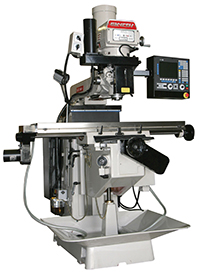Manual Mills & Lathes
Manual mills and lathes are responsible for monumental innovation in production and manufacturing over the decades. From basic invention in the 1800s until today, they continue to be refined and reproduced, even though their descendant, the CNC milling machine leads the way into the future.
Used Manual Mills & Lathes

Manual Milling Machines Then and Now
Brown & Sharpe revolutionized the manual mill in 1861 with the creation of the Universal Milling Machine which could mill on three axes. You can still find Brown & Sharpes in shops today.
Another milestone in the history of manual machines was designed by Bridgeport in 1936 and continued production through 2004. Like the Brown & Sharpe, these manual mills are so common that any vertical milling machine might be referred to as a Bridgeport in the machining community.Other companies like Wells Index Machine and Tool supplied numerous machines to the US military both before WWI and after. In fact, Wells Machine and Tool continues to produce manual mills (as well as CNC mills), made in Muskegon, Michigan.
The Basic Components of Manual Machines
Even though manual lathes and their relatives are very complex, there are some parts and assemblies more noteworthy than others. At the most basic level, milling machines have rotating cutters which remove material from a solid block by feeding a cutter along the block.
Parts that do the cutting and support the cutting are considered the tooling. Many types fall into this category drills, endmills, collets (that hold cutting tools), counterbores are just a few. An electric motor typically drives manual machines on an overarm ram. The motor drives the spindle, and a quill-feed wheel directs the quill. The workpiece is affixed to a worktable that can move longitudinally, as directed by a handwheel. The worktable is supported by the knee which has a saddle holding the table. There may be a cross traverse handwheel as well and a crank directs vertical movement.
For machining companies, hobbyists and manufacturing educational facilities, a manual machine serves a purpose distinct from the CNC mill which could make the same parts. Manual mills and manual lathes help new machinists learn the complexities of machining different types of materials since they can actually feel the changes in material hardness. A manual machine might be the fastest way to make a prototype or produce small quantities of a part not requiring extreme precision. From the 1800s to today, the manual machine continues its legacy shaping our world around us.
